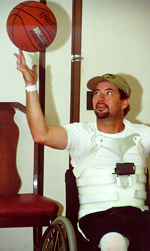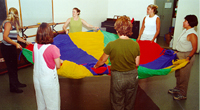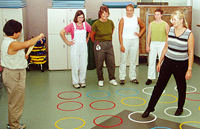RECREATION THERAPY: opening windows on new abilities
by Dick PetersonPublic Relations
When “I can’t” overpowers “I can,” walls close in, light dims and time drags.
And health suffers.
“Things they do in their leisure are the first to go,” said recreation therapist Cindy Ingels. “And in recovery, leisure time activities are the last to return.”
 Wheelchair-bound
Connie O’Donald spins a basketball on his finger during an impromptu game
in the recreation room in the main hospital.
Wheelchair-bound
Connie O’Donald spins a basketball on his finger during an impromptu game
in the recreation room in the main hospital.
Whether it’s an eating disorder, an addiction, a debilitating disease, maybe an injury or a permanent disability, or even dementia, it’s the loss—loss of control, loss of ability, loss of self esteem, loss of recollection—that can make recovery impossible.
Ingels, with recreation therapy coordinator Bob Raynor, both at the Institute of Psychiatry, and Amy Parker in MUSC’s Recreation Therapy Department in the main hospital have made it their careers to turn people’s “I can’ts” into “I cans.”
“As recreation therapists, we focus on a patient’s abilities and strengths as opposed to the pathology of their deficits,” Raynor said. For the rest of us, that means they follow an assessment of a patient’s abilities with ways to develop and expand those abilities through leisure activities — hobbies, sports, crafts, games — virtually any activity that combines measured challenge with a planned goal for recovery.
 Recreation
therapists in the Institute of Psychiatry and the MUSC Hospital demonstrate
activities designed to help psychiatry patients learn teamwork, follow
and trust instructions from others and experience the satisfaction of learning
crafts.
Recreation
therapists in the Institute of Psychiatry and the MUSC Hospital demonstrate
activities designed to help psychiatry patients learn teamwork, follow
and trust instructions from others and experience the satisfaction of learning
crafts.
“They can begin thinking they’ll never get out of the hospital,” Parker said. “They don’t want to stay. I don’t want them to stay.” Once that’s established, Parker and her patient can get to work on a plan.
Although each case is different, Parker’s plans always include one objective—to enjoy life. And although that prospect can seem unlikely to some of her patients—they can suffer from spinal cord and head injuries, strokes, amputations and severe burns—she helps them achieve that giant step toward “community re-integration.” That’s the re-hab jargon; her patients call it “re-entry.”
 A
colorful parachute keeps a ball in the air as team members work together
for a common objective.
A
colorful parachute keeps a ball in the air as team members work together
for a common objective.
She talked about taking a 15-year-old boy who lost the use of his arms and legs to a RiverDogs baseball game. The crowds were imposing. It seemed like everyone looked and looked down at him in his wheelchair. Barriers everywhere meant access was usually the long way around, which only meant more looks to endure and more pain.
“He was nervous about going,” Parker said. “But then the game lasted 13 innings and he wouldn’t leave ‘til it was over. He even went back to the concession stand by himself to get a straw.” Little victories like this are huge re-entry steps for Parker’s patients.
 A
game helps participants learn the way through a maze of rings by following
the hand signals of a team member with the map. One missed step and the
next member retraces the steps from memory and presses on.
A
game helps participants learn the way through a maze of rings by following
the hand signals of a team member with the map. One missed step and the
next member retraces the steps from memory and presses on.
She classifies barriers as physical and social.
“Overcoming physical barriers are often easier than the social,” Parker said. She explained how re-entry for a burn victim whose appearance is significantly marred or for a stroke patient whose speech is slurred requires encouragement and practice.
And the re-entry point is recreation. It’s a point where the patient can relax. Pressure’s off. Satisfaction’s the reward. And a return to at least some of the pastimes and perhaps a few new pleasures of living is the goal.
And health returns.
Sometimes recreation therapy is more re-creation, like when Ingels helps her patients with Alzheimer’s disease and dementia reminisce about the experiences of years gone by. By recalling and telling the stories of the past, they stimulate their ability for recollection in the present.
She also guides them in group brainstorming to solve crossword puzzles. First, “What are the synonyms?” Then, “Which have five letters? Any with ‘A’ and ‘R’ in them?” Ingels said, describing the step-by-step, one-piece-at-a-time procedure. “It stretches their brain power and slows down the progress of the dementia.”
One patient’s need required Ingles’ expertise working with eating disorders and Raynor’s with addictions. The case is an example of how each patient has a different therapy need and how each patient’s recovery becomes the focus of a team from psychiatrists to recreation therapists to social workers to psychiatric nurses to dietitians.
“I began with body image and how a woman’s body has been viewed through history, and then worked on the ‘fear foods’—fat and sugar,” Ingels said. She described the sheer terror a patient with an eating disorder experiences with just planning a menu and visiting the grocery store—no label-reading allowed. Label-reading is typically an obsession with patients suffering from eating disorders.
“Then we prepare the food and eat it,” she said. “I’m the safety net to experience what they experience and give them support.”
One item in Raynor’s bag of tricks is the Institute of Psychiatry Therapy Garden. Tucked away in an alcove behind the institute, the garden is a quiet spot for reflection and dirty, sweaty work. “She didn’t want to get her hands dirty, at first,” Raynor said. “But once we broke the activity down into small tasks, she began enjoying it.”
Raynor’s aim is to give his addiction patients pleasure-bearing, healthful activities to replace their health-destructive habits.
“Recreation therapy is all experiential,” he said. “We get folks to
experience things they enjoy and use those experiences as a learning process.”